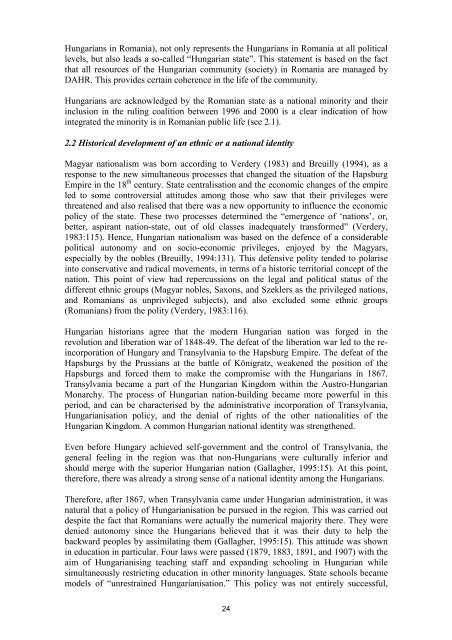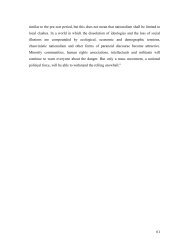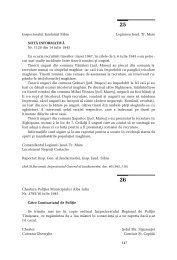Southeast Europe
Southeast Europe
Southeast Europe
Create successful ePaper yourself
Turn your PDF publications into a flip-book with our unique Google optimized e-Paper software.
Hungarians in Romania), not only represents the Hungarians in Romania at all political<br />
levels, but also leads a so-called “Hungarian state”. This statement is based on the fact<br />
that all resources of the Hungarian community (society) in Romania are managed by<br />
DAHR. This provides certain coherence in the life of the community.<br />
Hungarians are acknowledged by the Romanian state as a national minority and their<br />
inclusion in the ruling coalition between 1996 and 2000 is a clear indication of how<br />
integrated the minority is in Romanian public life (see 2.1).<br />
2.2 Historical development of an ethnic or a national identity<br />
Magyar nationalism was born according to Verdery (1983) and Breuilly (1994), as a<br />
response to the new simultaneous processes that changed the situation of the Hapsburg<br />
Empire in the 18 th century. State centralisation and the economic changes of the empire<br />
led to some controversial attitudes among those who saw that their privileges were<br />
threatened and also realised that there was a new opportunity to influence the economic<br />
policy of the state. These two processes determined the “emergence of ‘nations’, or,<br />
better, aspirant nation-state, out of old classes inadequately transformed” (Verdery,<br />
1983:115). Hence, Hungarian nationalism was based on the defence of a considerable<br />
political autonomy and on socio-economic privileges, enjoyed by the Magyars,<br />
especially by the nobles (Breuilly, 1994:131). This defensive polity tended to polarise<br />
into conservative and radical movements, in terms of a historic territorial concept of the<br />
nation. This point of view had repercussions on the legal and political status of the<br />
different ethnic groups (Magyar nobles, Saxons, and Szeklers as the privileged nations,<br />
and Romanians as unprivileged subjects), and also excluded some ethnic groups<br />
(Romanians) from the polity (Verdery, 1983:116).<br />
Hungarian historians agree that the modern Hungarian nation was forged in the<br />
revolution and liberation war of 1848-49. The defeat of the liberation war led to the reincorporation<br />
of Hungary and Transylvania to the Hapsburg Empire. The defeat of the<br />
Hapsburgs by the Prussians at the battle of Königratz, weakened the position of the<br />
Hapsburgs and forced them to make the compromise with the Hungarians in 1867.<br />
Transylvania became a part of the Hungarian Kingdom within the Austro-Hungarian<br />
Monarchy. The process of Hungarian nation-building became more powerful in this<br />
period, and can be characterised by the administrative incorporation of Transylvania,<br />
Hungarianisation policy, and the denial of rights of the other nationalities of the<br />
Hungarian Kingdom. A common Hungarian national identity was strengthened.<br />
Even before Hungary achieved self-government and the control of Transylvania, the<br />
general feeling in the region was that non-Hungarians were culturally inferior and<br />
should merge with the superior Hungarian nation (Gallagher, 1995:15). At this point,<br />
therefore, there was already a strong sense of a national identity among the Hungarians.<br />
Therefore, after 1867, when Transylvania came under Hungarian administration, it was<br />
natural that a policy of Hungarianisation be pursued in the region. This was carried out<br />
despite the fact that Romanians were actually the numerical majority there. They were<br />
denied autonomy since the Hungarians believed that it was their duty to help the<br />
backward peoples by assimilating them (Gallagher, 1995:15). This attitude was shown<br />
in education in particular. Four laws were passed (1879, 1883, 1891, and 1907) with the<br />
aim of Hungarianising teaching staff and expanding schooling in Hungarian while<br />
simultaneously restricting education in other minority languages. State schools became<br />
models of “unrestrained Hungarianisation.” This policy was not entirely successful,<br />
24









